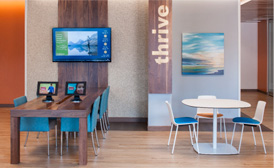You walk in, verify at a kiosk that you’ve already checked in and paid, plug in your laptop at the charging station, and soon get a text that it’s your turn. No — you’re not at Starbucks — you’re at Kaiser Permanente’s new Signal Hill Medical Office in Southern California for your medical appointment.
 Signal Hill exemplifies Kaiser Permanente’s most recent effort of evolving its care model to better integrate into members’ lives.
Signal Hill exemplifies Kaiser Permanente’s most recent effort of evolving its care model to better integrate into members’ lives.
“Granddad’s medical office building doesn’t cut it anymore,” said Don Orndoff, senior vice president, National Facilities Services. “We’ve all now become accustomed to the Amazon and Uber experience and that’s our new expectation.”
The medical office of the future at Kaiser Permanente means harnessing design, technology and workflow to create an intuitive and convenient experience for members and care teams. It also means developing a much more agile and flexible environment that meets the evolving technology and service needs of those increasingly tech-savvy members and care teams.
Convenience and care under one roof
Signal Hill opened to Kaiser Permanente members on June 29, 2016, and its sleek architectural design doesn’t disappoint. But it’s the convenient technology features and efficient spaces inside that really impress. When you walk inside the building, you enter into the “public square.”
Since members have the option of checking in and handling their copayments at home, a quick visit to the kiosk allows them to take advantage of a number of options available to them in the public square. They can engage with others at the community table or use computers at the docking station. Or, they can decompress in a quiet spot on the upstairs “porch.” In fact, members can use their time wherever they wish because once the provider is ready, the member will receive a text message.
At the pharmacy, there is also no need to wait around. You’ll receive a text when your medication is ready.
 The exam rooms don’t look traditional either. Instead of the long, awkward exam table and steel chairs, there’s a comfortable reclining chair and a couch for family seating. The care team also uses hand-held tablets, which is not only easier for them, but avoids having the member stare at the back of a big computer monitor. On the wall, there’s a large monitor for virtual visits or patient education programs.
The exam rooms don’t look traditional either. Instead of the long, awkward exam table and steel chairs, there’s a comfortable reclining chair and a couch for family seating. The care team also uses hand-held tablets, which is not only easier for them, but avoids having the member stare at the back of a big computer monitor. On the wall, there’s a large monitor for virtual visits or patient education programs.
Read more of this story here.




